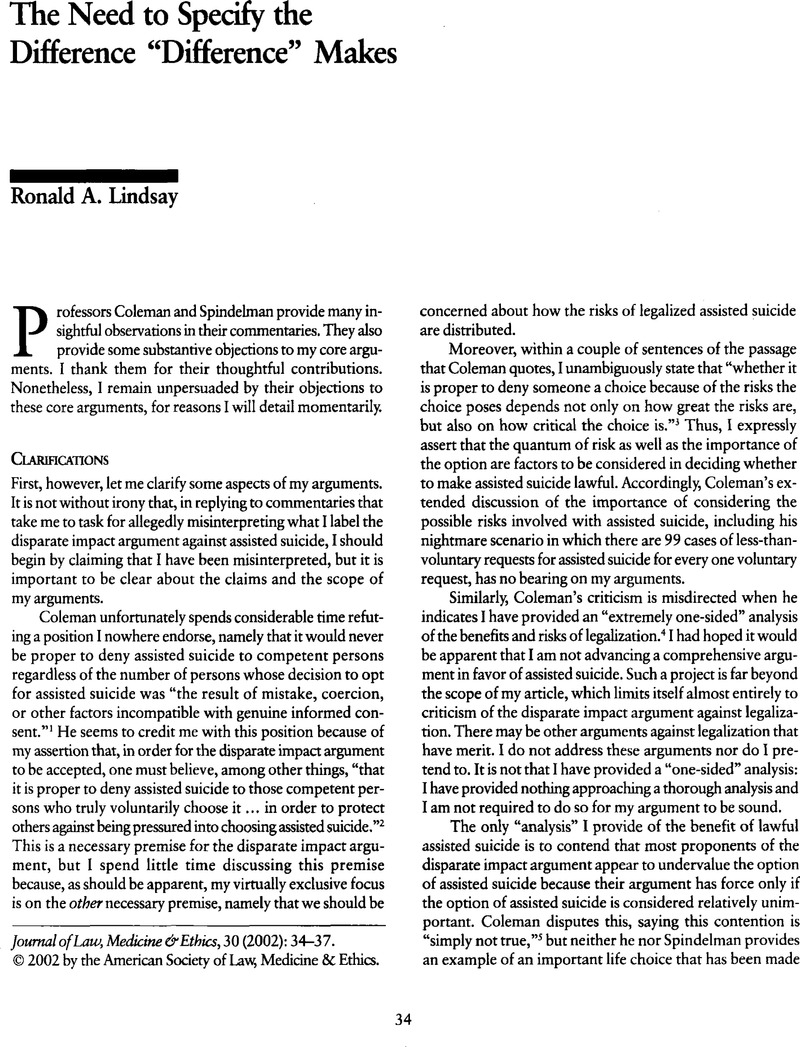No CrossRef data available.
Article contents
The Need to Specify the Difference “Difference” Makes
Published online by Cambridge University Press: 01 January 2021
Abstract
An abstract is not available for this content so a preview has been provided. Please use the Get access link above for information on how to access this content.

- Type
- Article
- Information
- Copyright
- Copyright © American Society of Law, Medicine and Ethics 2002
References
Coleman, C., “The ‘Disparate Impact’ Argument Reconsidered: Making Room for Justice in the Assisted Suicide Debate”, Journal of Law, Medicine & Ethics, 30, no. 1 (2002): 17–23, at 18.CrossRefGoogle Scholar
Lindsay, R., “Should We Impose Quotas? Evaluating the ‘Disparate Impact’ Argument Against Legalization of Assisted Suicide,” Journal of Law, Medicine & Ethics, 30, no. 1 (2002): 6–16, at 6.CrossRefGoogle Scholar
Id. at 6–7. Coleman sums up his criticism of me on this issue by stating that “[a]s a matter of public policy, neither the risks nor the benefits of legalization are themselves determinative; each is relevant and must be balanced against the other.” Coleman, , supra note 1, at 18. I do not see how this proposition differs from what I have asserted.Google Scholar
There is one author who uses the disparate impact argument in the context of assisted suicide who recognizes both the possibility that assisted suicide presents an important option and that the importance of this option can make a difference as to whether assisted suicide should be legalized. In his article, “Physician-Assisted Suicide in the Dark Ward: The Intersection of the Thirteenth Amendment and Health Care Treatments Having Disproportionate Impacts on Disfavored Groups,” Seton Hall Law Review, 28 (1998): 776–896, at 798, Larry Pittman states that if “investigations show that pain medication is ineffective for many patients who can afford the medication, physician-assisted suicide should be legalized,” id. at 798, with the caveat that if statistics show a “disproportionate impact on members of racial minority groups or members of any racial group,” then “a disproportionate impact claim under the Thirteenth Amendment” could be used as a “means of challenging the constitutionality of a state statute allowing physician-assisted suicide.” Id. at 885. Effectively, Pittman maintains that if the option of assisted suicide is important, disparate impact can and should make a difference after legalization, but not before.Google Scholar
Actually, Pittman, supra note 6, at 877–80, expressly references Title VII in his discussion of the use of disparate impact analysis in the context of assisted suicide, although he does maintain that the “standards for evaluating a disproportionate impact claim under the Thirteenth Amendment… should not be based on the standards that the federal courts have created under Title VII” because of the alleged “confusion surrounding” application of these standards. Id. at 879-80.Google Scholar
Coleman, C. and Miller, T., “Stemming the Tide: Assisted Suicide and the Constitution,” Journal of Law, Medicine & Ethics, 23 (1995): 389–97, at 393.CrossRefGoogle Scholar
The U.S. Supreme Court has expressly held “that subjective or discretionary employment practices may be analyzed under the disparate impact approach in appropriate cases.” Watson v. Fort Worth Bank & Trust, 487 U.S. 977, 991 (1988).Google Scholar
Spindelman, M.S., “Legislating Privilege,” Journal of Law, Medicine & Ethics, 30, no. 1 (2002): 24–33, at 25.CrossRefGoogle Scholar
New York State Task Force on Life and the Law, When Death Is Sought: Assisted Suicide and Euthanasia in the Medical Context (New York: New York State Task Force on Life and the Law, 1994), at 125–26 (emphasis added). Coleman quotes this passage at 20; Spindelman quotes this passage at 26.Google Scholar
Id. at 27.Google Scholar
Id. at 28.Google Scholar
The need for such privileged access perhaps gives a new, unanticipated meaning to Spindelman's reference to “legislating privilege.”Google Scholar
Id. at 29.Google Scholar
Vonnegut, K., “Harrison Bergeron,” Welcome to the Monkey House (New York: Delta, 1998): 7–14. I do not think that Spindelman would actually go to such extremes, but an obvious problem with limiting a person's choices until we eliminate all inequalities that could influence that person's choices is that there is no logical stopping point. Although Spindelman, supra note 12, at 28–29, criticizes me for working with an inadequate concept of autonomy, the concept that I implicitly use in my article is consistent with accepted understandings of autonomy in both law and ethics, whereas his understanding appears to incorporate aspirational ideals that are never likely to be realized. See Faden, R.R. and Beauchamp, T.L., A History and Theory of Informed Consent (New York: Oxford, 1986): at 240-41. Almost everyone has to make consequential decisions under less than ideal conditions, and the cost of requiring ideal autonomy as a precondition to choice is that virtually no one will have freedom of choice.Google Scholar




